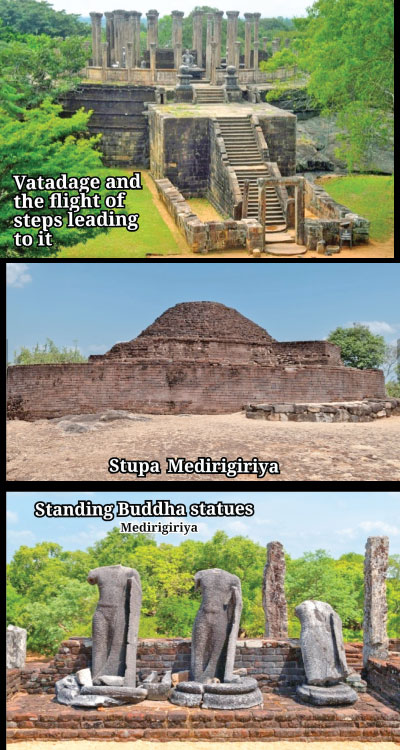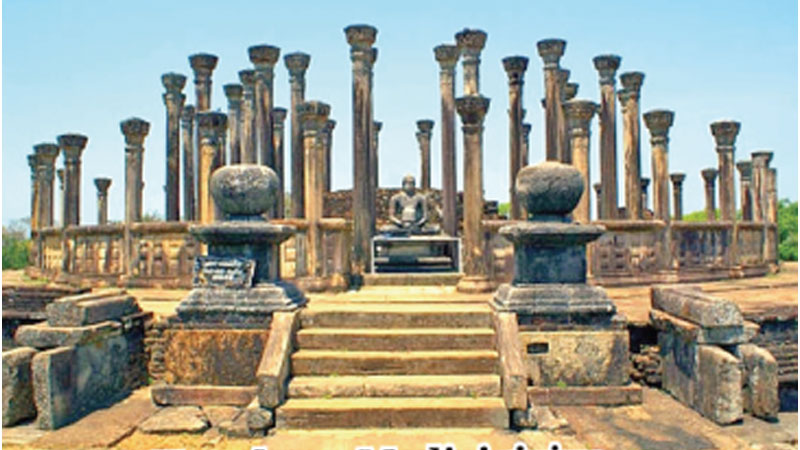Medirigiriya is 34 kms to the North of Polonnaruwa and can be reached in a bus from Hingurakgoda in about 23 minutes. By 1950, Medirigiriya had been a densely-wooded area infested with elephants, leopards and bears. But later thanks to agricultural schemes, the area first became sparsely populated and then gradually began to be lived in by thousands of people.
 Though small in extent, this historic Medirigiriya archaeological site has in it several awe-inspiring architectural monuments. It is most famous because of the impressive Vatadage, Sri Lanka’s best well-preserved vatadage (a circular stupa- house) also containing a Buddha statue in the centre. The area with it and other monastic remains has a history dating back to the pre-Christian era and it had been a major Buddhist place of worship up to the 13th century AD.
Though small in extent, this historic Medirigiriya archaeological site has in it several awe-inspiring architectural monuments. It is most famous because of the impressive Vatadage, Sri Lanka’s best well-preserved vatadage (a circular stupa- house) also containing a Buddha statue in the centre. The area with it and other monastic remains has a history dating back to the pre-Christian era and it had been a major Buddhist place of worship up to the 13th century AD.
It is stated in the Mahawamsa that King Kanittatissa (167 AD – 186 AD) made an Uposathaghara (a chapter house) at Mandalagiri Vihara. Later, during the reign of King Aggabodhi IV (667 AD- 685 AD), affluent Malayaraaja was said to have built the vatadage or chetiyaghara (a stupa- house). King Sena II ( 855 AD – 887 AD) was also a righteous ruler who was passionately interested in the development of this structure. He was impressed by the Vatadage at Medirigiriya and renovated it with personal wealth and donated the temple many villages too.
Sanatorium
It has been revealed in the inscriptions found at the site that there was even a sanatorium in the precincts of the Medirigiriya Rajamaha Vihara, which was built as a state- sponsored shrine in the 9th and the 10th centuries.
In the 10th century, Madirigiriya Vatadage, as well as other Buddhist monuments may have been damaged by Cholas who conquered Sri Lanka. But King Vijayabhahu I (1055 AD – 1110 AD), who chased away Cholas, restored and revived the Buddhist monastic complex.
Medirigiriya, which was a prominent Raja Maha Vihara in the country for many ages, disappeared in the thick forest due to the Magha invasion in the 13th century and the shift of the capital from Rajarata to the South- West region.
In the recent past, Medirigiriya again attracted archaeological attention after H.C.P Bell, the then Archaeological Commissioner rediscovered the site in 1897.
The first thing that catches the eye of anyone who goes to this place is the Vatadage on a slightly elevated boulder. The entrance to this is on the Northern side. There is a flight of 27 steps to the Vatadage. The staircase begins with a moonstone without carvings and the interior design is similar to that of the Polonnaruwa Vatadage.
Concentric circles
Around the stupa are three concentric circles of octagonal pillars. Their pillar heads resemble those of the Thuparama in Anuradhapura. The number of pillars in the innermost circle is 16 and a pillar is 9 inches apart. One pillar is 17 feet high with the head. The second circle of pillars is 6 feet and 3 inches from the innermost circle. It has 20 pillars and the height of each pillar is 16 feet. The last circle of pillars is 14 feet and 5 inches from the second circle and the number of pillars is 32 and each pillar is 9 feet high. The special feature is the 3 feet 6 inches high stone cover wall that surrounds the enclosure.
 The square image house situated to the North-West of the Vatadage is 50 feet in length and 35 feet in width. Two large limestone Buddha statues, another one with a broken leg and two other broken statues can also be seen there. There are ruins of three other image houses at the site.
The square image house situated to the North-West of the Vatadage is 50 feet in length and 35 feet in width. Two large limestone Buddha statues, another one with a broken leg and two other broken statues can also be seen there. There are ruins of three other image houses at the site.
On the rock to the North of the Vatadage is a stupa whose diameter is 45 feet. There are 25 steps cut into the rock to access it. It has been vandalised by treasure hunters, but a good portion of it can still be seen.
The Vatadage at Medirigiriya and many other historic monuments there constitute a marvelous open art gallery whose unique creations amaze the world.









